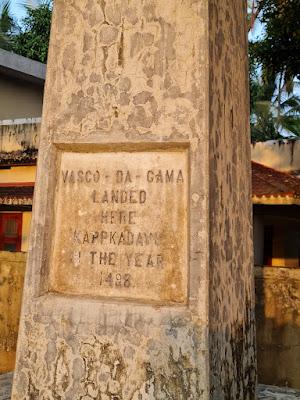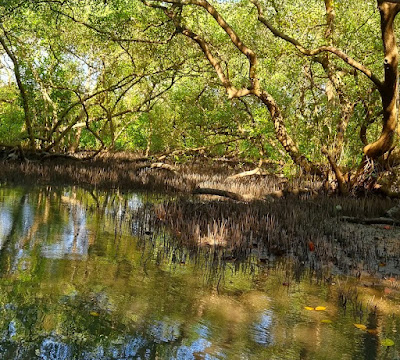History and life don’t always agree on what’s important. Both, in their own ways, suffer from a lack of lasting perspective. Events once hailed as momentous often fade into obscurity, while seemingly minor incidents sometimes go on to define entire epochs. It’s a humbling realization—that the so-called “game-changing” moments of the past may now live only in the margins, forgotten by the very places and people they once touched.
I was fortunate—or perhaps sobered—to encounter such a moment of collective amnesia during a recent visit to Kozhikode (Calicut). Here, in this coastal city cradled by the Arabian Sea, history quite literally landed one day centuries ago. And yet, as I wandered its streets, that legacy felt strangely muted.
I love my work most when it leads me to new places—when it opens doors not just to conference rooms and files, but to hidden stories, unfamiliar streets, and forgotten corners of history. My recent trip to Kozhikode (Calicut) began as a routine work visit. But as with many places in Kerala, it didn’t take long for the landscape to cast its quiet spell.
Kozhikode, the historical capital of the Malabar region, was once the mighty seat of the Zamorins—rulers whose maritime prowess turned this coastline into a vibrant hub of spice trade. But beyond its local legacy, Kozhikode holds another monumental place in global history: this is where the Portuguese explorer Vasco da Gama first set foot in India in 1498, opening the sea route that would change the course of empires.
You would expect such a momentous event to be marked with grandeur. And yet, near the golden sands of Kappad beach, all that stands is a modest, barely noticed plaque declaring that “Vasco da Gama landed here in 1498 AD.” That’s it—no museum, no interactive display, no storytelling installation. Just a small stone, weathered by salt and sun, bearing silent witness to an event that reshaped continents.
The irony was striking. This beach was once the threshold between two worlds—Europe and India—yet today, it’s a quiet stretch of sand where children play, vendors sell ice cream, and the waves continue their rhythm, indifferent to the tides of history.
Kappad Beach was nothing short of magnificent—surprisingly secluded, astonishingly pristine. Except for a small stretch where tourists mingled with local children, the shore belonged mostly to birds and crabs. The golden sand shimmered beneath the caress of gentle waves, while egrets and storks danced along the tide in quiet joy.
Even in the human-inhabited corner, life flowed gently. Children played with unbridled glee, their laughter rising above the sound of the surf. Nearby, fishermen stood by their boats, haggling over the day’s fresh catch—straight from the sea, still gleaming, still alive with salt and story.
There was a tranquil rhythm to it all, like a poem written in sand and sea breeze. I found myself wondering how such a gem of a place had escaped the intrusive glare of mass tourism. And then, I silently thanked the universe for that stroke of fortune—for letting Kappad remain untouched, unhurried, and deeply, undeniably poetic.
The city beach of Kozhikode stood in stark contrast to the serene solitude of Kappad. Here, noise replaced silence, and human presence overwhelmed the natural rhythm of the sea. It was alive—but in a way that felt more chaotic than charming.
The Kerala Book Fest was underway, and the entire beachfront had transformed into a maze of makeshift stalls, vendor carts, and throngs of students and visitors. Every inch of sand seemed claimed—by book displays, food counters, or selfie-taking groups. The vibrant energy might have felt festive to some, but on that hot and humid afternoon, it felt almost suffocating.
Plastic wrappers fluttered in the breeze. Loudspeakers competed with the chatter of crowds. Even the sea seemed muted beneath the cacophony of human activity. After the poetic quietude of Kappad, this urban beach reminded me how quickly natural beauty can be drowned in noise, unless fiercely preserved.
The magic of Malabar wasn’t done with me just yet. At sunrise, I found myself in Kadalundi—around 20 kilometers from the heart of Calicut—just as the first light kissed the water. Kadalundi–Vallikkunnu Community Reserve, nestled at the estuary where the Kadalundi River meets the Arabian Sea, holds the distinction of being India’s first riverfront community reserve on the Malabar Coast.
It is a place where land and water meet not just geographically, but also in spirit. The reserve includes a bird sanctuary and thriving mangrove swamps—forming a delicate ecosystem that shelters a fascinating array of native and migratory birds, insects, and aquatic life.
Gliding into the mangroves in a small wooden boat, I was struck by how intimate the experience felt. The silence was broken only by the rhythmic splash of the oar and the occasional calls of birds overhead. A large colony of seagulls had claimed an island in the estuary, their chatter filling the air as they nested in peace. The damp, dark soil shimmered with seashells and coral fragments—remnants of an ancient conversation between sea and land.
It wasn’t just a journey through a protected natural space; it felt like entering a world where humans were not intruders, but participants. This was my most memorable encounter with social forestry—an example of what community-led conservation can achieve when nature is treated as a neighbor, not a resource.
Later that day, we journeyed from the dense, breathing green of Kadalundi’s mangroves to the windswept shores of Beypore. At first glance, Beypore may seem like just another port town—modest, functional, perhaps even unremarkable. But its shores hold a secret whispered only to those who pause and listen. Here, under the open sky and beside the ancient Chaliyar River, lives a craft that connects Kerala to the distant lands of Arabia—a tradition of shipbuilding that dates back over a thousand years.
This is the home of the Uru—the legendary wooden dhow, once the lifeblood of maritime trade between India and the Middle East. These majestic vessels, called "Fat Boats" for their wide girth, were designed to carry heavy loads across vast oceans, and today they are the largest handcrafted boats in the world. To witness the making of a Uru is to witness living history—no blueprints, no computers, no formal manuals. Just the inherited wisdom of generations of craftsmen, passed down through memory and muscle, heart and hand.
Beypore’s shipyards don’t shout their legacy; they hum it quietly. From the outside, they look like any other industrial space—timber stacked high, tools scattered, workmen deep in concentration. But if you look closer, it unfolds as a story of extraordinary craftsmanship, deep-rooted cultural exchange, and India's ancient seafaring connections with Mesopotamia and the Arab world.
Once used to ferry spices, textiles, and treasures across oceans, these Urus now often find new lives as luxury yachts in the Gulf. Yet they remain faithful to their origins—still crafted from the famed teakwood of Nilambur forests, still built by hand on the very islands that dot the Chaliyar River, and still echoing the rhythm of a thousand years of tradition.
Standing there, among the scent of timber and the sounds of wood being chiseled and caressed into form, I couldn’t help but feel I was in the presence of something sacred. Not just boats—but heritage, memory, and the silent pride of a community that has shaped the oceans with their hands.
These boats are not just vessels—they are living sculptures, embodying a unique architectural genius honed by a specially skilled group of artisans from Malabar. What’s most astounding is that there are no blueprints, no sketches, no digital plans guiding the construction of a Uru. Everything, from conception to completion, lives in the mind of the maistry—the master builder—whose intuition and inherited wisdom guide the process with uncanny precision. It’s as if the boat flows from memory, spirit, and skill—like magic, every single time.
In traditional methods, not a single iron nail was used. This wasn’t just for aesthetics—it was practical. Iron rusts, and rust leads to leaks in the salty sea. So instead, the wooden planks were sewn together—yes, literally stitched—with coir rope, and then sealed with resin. The craftsmanship is as poetic as it is functional, a rare symphony of ingenuity and sustainability.
Woven into this story is the seafaring heritage of the Mappila Khalasis—a legendary community whose strength, teamwork, and rhythm have powered the launch of these giant boats for centuries. There’s a saying in Malayalam that goes “Othupidichal Malayum Porum”, which means, “If we act together, even mountains can be moved.” It’s not just a proverb—it’s a living truth in the hands of the Khalasis.
Watching them work is nothing short of mesmerizing. There are no cranes or hydraulic machines in sight. Only wooden rollers, sturdy ropes, pulleys, and the sheer willpower of dozens of synchronized human beings. They chant in unison as they push, pull, and guide vessels that weigh hundreds of tons—from land to sea and back again. It’s an ancient performance—raw, rhythmic, and deeply spiritual.
The energy of their collective effort is infectious. You don’t just see it—you feel it in your bones. And to truly grasp the magnitude of their creation, you must stand beside one of these majestic Urus, or better yet—climb onto one, as I did. Only then can you comprehend their true scale, their grace, and the soul embedded in every grain of wood.
To witness this tradition in a quiet construction yard near Beypore was one of the most humbling experiences of my journey. It made me realize how much of our world still runs on the brilliance of human hands, on ancestral knowledge, and on the silent strength of communities who carry their history forward with pride.
No account of Kozhikode would be complete without a tribute to its famed spices and cuisine. After all, this city—once a thriving hub of the global spice trade—is often called the mecca of Malabar pepper. The best-quality black pepper and a host of other aromatic spices have been cultivated in the verdant hills around here for centuries, bringing not only prosperity but also a rich, multicultural legacy to the region.
And the cuisine that blossomed from this legacy is just as enchanting. From the bustling street corners to elegant dining halls, the Malabari table is a celebration of warmth, hospitality, and depth of flavour. I had the privilege of dining at the legendary Paragon restaurant—where even for a staunch vegetarian like me, the experience was unforgettable. The flaky Malabar parotta and its delicate, noodle-like cousin nool parotta were sheer indulgence—soft, layered, golden perfection paired with spicy, fragrant gravies. Even the humble banana chips and pickles packed more flavour than one could expect from their simple appearance.
As I boarded the train for my return journey, the landscape began to recede—golden sands, quiet rivers, and the mangrove swamps of Kadalundi. But this time, they didn’t feel like just places I had visited. The mangroves, glowing in the twilight, stirred something unexpected in me—a wave of nostalgia for a place that had only recently entered my life. I suddenly realized that I was far away from the places I’ve always called home. And yet, a part of me felt rooted here too, as if something ancient and enduring had quietly woven itself into my memory.









No comments:
Post a Comment